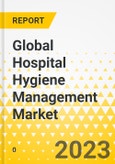This report comes with 10% free customization, enabling you to add data that meets your specific business needs.
The global hospital hygiene management market has seen significant advancements in recent years, driven by the increasing emphasis on patient safety, infection control, and the ongoing COVID-19 pandemic. This report provides an in-depth analysis of the evolving landscape of hospital hygiene management, with a specific focus on new innovations in the industry. The three key areas of innovation discussed in this report include Artificial Intelligence (AI) and digital innovation, robotics, and hygiene adherence and monitoring.
Introduction
Hospital hygiene management is a critical component of healthcare, as it directly impacts patient outcomes, infection control, and the overall quality of healthcare services. In an era where the importance of infection prevention is paramount, advancements in technology have revolutionized the approach to hospital hygiene management.
Market Overview
This section provides an overview of the global hospital hygiene management market, including market size, growth trends, and key drivers.
Market Size and Growth
- Factors driving this growth include the increasing prevalence of hospital-acquired infections, heightened awareness of hygiene in healthcare settings, and the adoption of innovative technologies.
New Innovations in Hospital Hygiene Management
This section delves into the three key innovations transforming hospital hygiene management.
AI and Digital Innovation
- AI-powered solutions are becoming increasingly prevalent in hospital hygiene management. These solutions offer predictive analytics, real-time monitoring, and data-driven insights to optimize hygiene protocols.
- Digital innovations include mobile apps for staff training, real-time hygiene tracking, and cloud-based platforms for managing hygiene-related data.
- The integration of AI and digital technologies has enhanced the efficiency and effectiveness of hospital hygiene management practices.
Robotics
- Robotics has revolutionized the way hospitals manage hygiene. Autonomous robots equipped with sanitization equipment can efficiently disinfect high-touch areas, reducing the risk of infections.
- Robot-assisted UV-C disinfection and autonomous cleaning robots have gained popularity in healthcare settings, ensuring thorough and consistent cleaning.
- The adoption of robotics has not only improved hygiene but also reduced the workload on hospital staff.
Hygiene Adherence and Monitoring
- Monitoring and adherence solutions employ wearable devices and sensors to track the hygiene practices of healthcare professionals.
- Real-time feedback and alerts ensure that healthcare workers follow proper hygiene protocols, including hand hygiene and personal protective equipment use.
- These technologies play a crucial role in reducing the spread of infections within hospitals.
Market Trends and Opportunities
This section outlines the emerging trends and opportunities in the global hospital hygiene management market, emphasizing the importance of innovation.
Remote Monitoring and Telemedicine
- The adoption of telemedicine has surged, creating a need for remote monitoring of patients and their environment.
- Hospital hygiene management solutions are adapting to support remote monitoring and control, ensuring the safety of both patients and healthcare providers.
Increasing Investments in R&D
- Research and development efforts in hospital hygiene management are on the rise, focusing on developing more advanced AI algorithms, robotics, and monitoring systems.
- Market players are actively investing in innovative solutions to stay competitive in the evolving landscape.
This product will be delivered within 5-7 business days.
Table of Contents
Companies Mentioned
- B. Braun
- Ecolab Inc.
- CenTrak
- PAUL HARTMANN AG
- Weiss Technik
- 3M
- Xenex
- Hamilton Medical
- Reckitt Benckiser
- Procter and Gamble
- Blue Ocean Robotics
- American Air Filter Company, Inc.
- Camfil
- Swisslog Healthcare GmbH
- The Clorox Company
- Colgate-palmolive
- GOJO Industries
- S.C. Johnson
- Uvrobots
- Freudenberg Filtration Technologies GmbH & Co. KG
- Steriliz LLC
- Iso-Aire
- AeroMed
- Biovigil
*List of company profiles is tentative it may change with the course of research
**The financials will be provided for the public companies only








